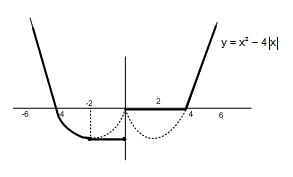12th Grade > Mathematics
APPLICATION OF DERIVATIVES MCQs
Total Questions : 58
| Page 2 of 6 pages
Answer: Option C. -> 3
:
C
We have, y = cos (x + y)
dydx=sin(x+y)(1+dydx)
Since, the tangents are parallel to the line x + 2y = 0
−12=−sin(x+y)(1−12)⇒sin(x+y)=1⇒x+y=π2,5π2,3π2−1≤y≤1.
Hence (c) is the correct answer.
:
C
We have, y = cos (x + y)
dydx=sin(x+y)(1+dydx)
Since, the tangents are parallel to the line x + 2y = 0
−12=−sin(x+y)(1−12)⇒sin(x+y)=1⇒x+y=π2,5π2,3π2−1≤y≤1.
Hence (c) is the correct answer.
Answer: Option A. -> parallel to the x-axis
:
A
dxdθ=−a√cos2θsinθ+−acosθsinθ√cos2θ=−a(cos2θsinθ+cosθsin2θ)√cos2θ=−asin3θ√cos2θ=dydθ=a√cos2θcosθ−asinθsin2θ√cos2θ=acos3θ√cos2θ
Hence dydx=−cot3θ⇒dydx|θ=π6 = 0
So the tangent to the curve at θ=π6 is parallel to the x-axis.
:
A
dxdθ=−a√cos2θsinθ+−acosθsinθ√cos2θ=−a(cos2θsinθ+cosθsin2θ)√cos2θ=−asin3θ√cos2θ=dydθ=a√cos2θcosθ−asinθsin2θ√cos2θ=acos3θ√cos2θ
Hence dydx=−cot3θ⇒dydx|θ=π6 = 0
So the tangent to the curve at θ=π6 is parallel to the x-axis.
Answer: Option B. -> f(x1 + x22)
:
B
Let A = (x1,f(x1)) and B = (x2,f(x2)) be any two points on the graph of y = f(x).
Since f"(x) > 0, in the graph of the function tangent will always lie below the curve. Hence chord AB will lie completely above the graph of y = f(x).
Hence f(x1)+f(x2)2>f(x1+x22)
:
B
Let A = (x1,f(x1)) and B = (x2,f(x2)) be any two points on the graph of y = f(x).
Since f"(x) > 0, in the graph of the function tangent will always lie below the curve. Hence chord AB will lie completely above the graph of y = f(x).
Hence f(x1)+f(x2)2>f(x1+x22)
Answer: Option B. -> -42
:
B
We have,
x=t3−12t2+6t+8
⇒dxdt=3t2−24t+6andd2xdt2=6t−24
Now, Acceleration =0
⇒d2xdt2=0⇒6t−24=0⇒t=4
Att=4, we have
Velocity =(dxdt)r−4=3×42−24×4+6=−42.
Hence (b) is the correct answer.
:
B
We have,
x=t3−12t2+6t+8
⇒dxdt=3t2−24t+6andd2xdt2=6t−24
Now, Acceleration =0
⇒d2xdt2=0⇒6t−24=0⇒t=4
Att=4, we have
Velocity =(dxdt)r−4=3×42−24×4+6=−42.
Hence (b) is the correct answer.
Answer: Option C. -> (3, ∞)
:
C
f(x)=2x3−3(2+λ)x2+12λx⇒f′(x)=6x2−6(2+λ)x+12λf′(x)=0⇒x=2,λ
If f(x) has exactly one local maximum and exactly one local minimum, then λ≠2.
:
C
f(x)=2x3−3(2+λ)x2+12λx⇒f′(x)=6x2−6(2+λ)x+12λf′(x)=0⇒x=2,λ
If f(x) has exactly one local maximum and exactly one local minimum, then λ≠2.
Answer: Option D. -> 3,13
:
D
Let y=x3−5x2+5x+8. Then,
dydx=(3x2−10x+5)dxdtWhendydt=2dxdt,wehave(3x2−10x+5)dxdt=2dxdt⇒3x2−10x+3=0⇒(3x−1)(x−3)=0⇒x=3,13.
Hence (d) is the correct answer.
:
D
Let y=x3−5x2+5x+8. Then,
dydx=(3x2−10x+5)dxdtWhendydt=2dxdt,wehave(3x2−10x+5)dxdt=2dxdt⇒3x2−10x+3=0⇒(3x−1)(x−3)=0⇒x=3,13.
Hence (d) is the correct answer.



















